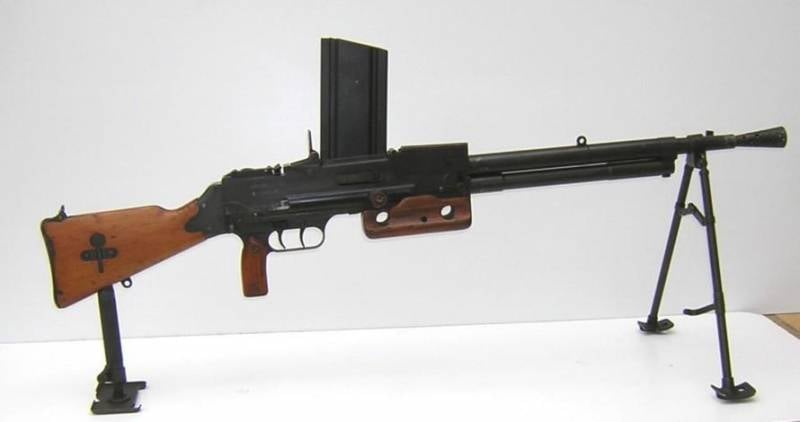
Machine gun FM Mle 1924/29 “Chatellerault”. Photo littlegun.be
Alexei Tolstoy, Gloomy Morning
stories about weapon. And it so happened that in the early 1900s, Samuel McClean, a doctor by training, abandoned his medical practice at the age of 40 and designed, and even managed to make a large 37-mm automatic gun in metal, which was mounted on a pedestal in the back of a truck. True, he did not succeed with a cannon, and then he began to develop a rifle-caliber machine gun. By 1920, he received more than 30 patents in his name, but his most important achievement was the development of a light machine gun with a gas engine.
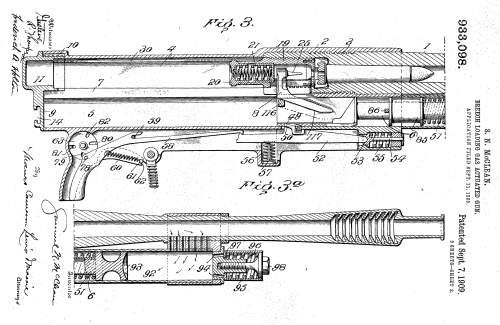
Diagram of a McClean machine gun from a 1909 patent
In 1918-1919, McClean tried to create another light machine gun and … created it, and its main feature was the absence of a fire translator. Instead, without turning around for a long time, he used a pair of triggers: the rear for semi-automatic fire and the front for fully automatic. And although this innovation as a whole did not take root in weapons practice, in a country like France, on the basis of its development, even its own light machine gun was created, replacing the useless Chauchat for many years.
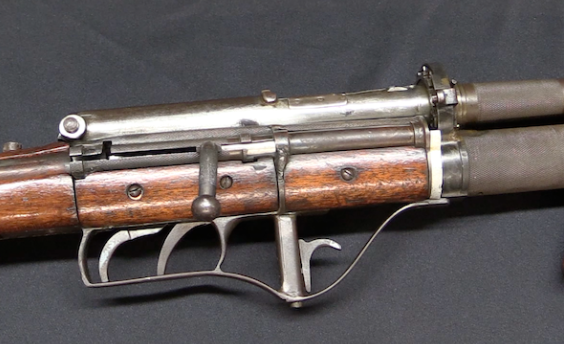
Two triggers – one of the “highlights” of the McClin machine gun. Photo forgottenweapons
The French army took care of the issue of replacing it immediately after the end of the First World War. Considering the situation in which she found herself with the Chauchat completely intolerable, and realizing that you couldn’t win much with heavy machine guns alone, the French military decided to adopt the American Browning Automatic Rifle (BAR), but in the end they still considered more profitable to develop their own weapons.
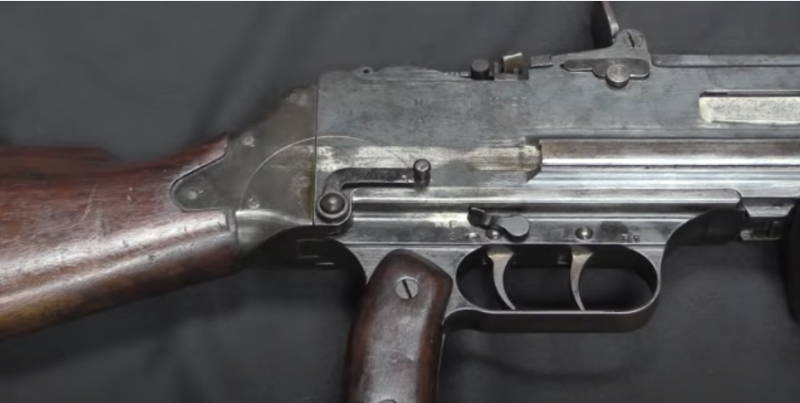
This photo clearly shows a number of distinctive features of the Chatellerault machine gun: on the left – the handle in the rear of the receiver served to facilitate the disassembly of the machine gun, with its help the locking bolt was unscrewed and the butt was separated; above the rear trigger is the safety lever. Photo forgottenweapons
After that, MAS (an abbreviation for Manufacture d’Armes de St. Etienne – one of several state-owned arms factories in France), borrowing something from BAR and something from other samples, created its own light machine gun, developed by Lieutenant Colonel Reibel with the assistance of chief armorer Chosse. Moreover, it was already created under the new 7,5 mm cartridge, which replaced the old 8 mm. So there was a weapon called “Automatic rifle mod. 1924” or Fusil-mitrailleur Mle 1924.
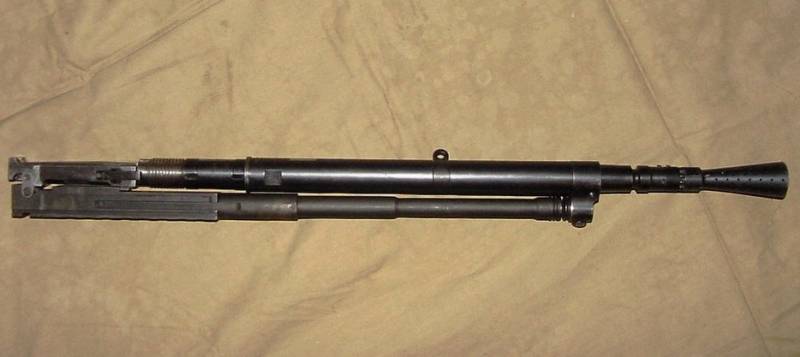
Gas engine, barrel and bolt of the Chatellerault machine gun. Photo littlegun.be
Already at the end of May 1925, FM Mle 1924 was put into mass production and again in May 1926 took part in the battles in Morocco against the reefs. It was immediately well received by the troops, especially since it favorably differed for the better from the Chauchat and was comparable in its characteristics to the much heavier Hotchkiss heavy machine gun. However, the problems with the new 7,5mm cartridge proved to be so significant that the French had to develop the shorter 7,5×54mm cartridge, which from 1929 became the standard for all future rifles and light machine guns in French service. A new modified version of the Fusil-mitrailleur modèle 1924 was named FM Mle 1924/M29 and was mass-produced from 1930. 187 of these machine guns were made, and earlier samples were re-barreled for new 412 × 7,5 mm ammunition.
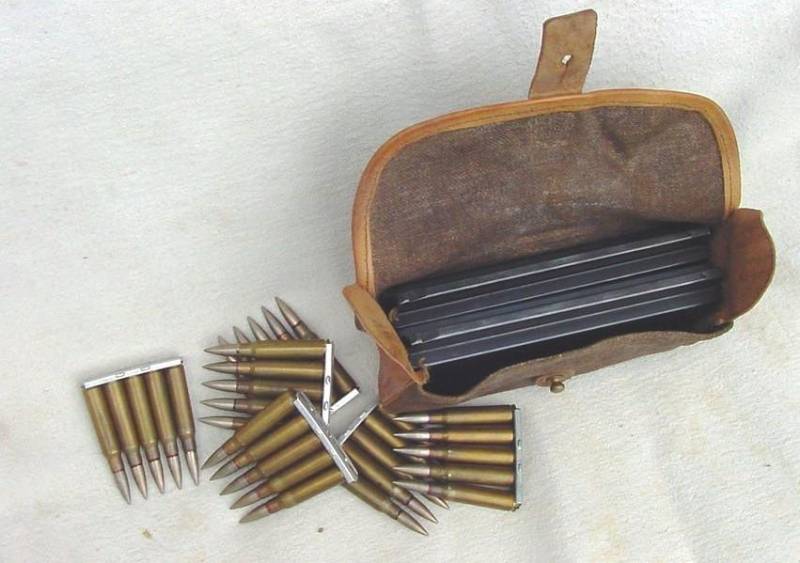
Magazine in a case and clips with 7,5×54mm cartridges. Photo littlegun.be
The new French machine gun took all the best from the models that performed well during the war years, and some later innovations. The machine gun had a 25-round detachable magazine inserted from above, a bolt held by a slide delay after the last cartridge had been fired from the magazine, and two separate triggers, as on an experienced McClean machine gun: a front trigger for single shots and a rear trigger for automatic firing.
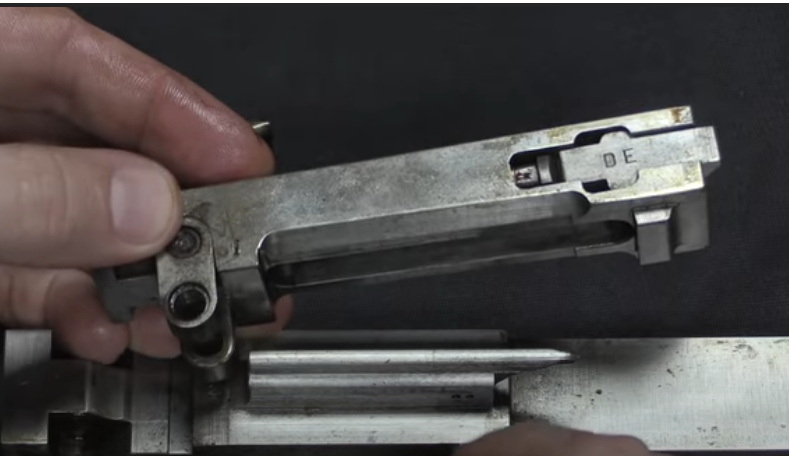
Shutter photo. The locking of the Chatellerault barrel, by analogy with the Browning automatic rifle, was carried out by tilting the bolt in its rear part, where there were two movable earrings on a common axis. When moving forward, the barrel ran into a ledge on the frame at the top and, accordingly, warped, locking the barrel. But the drummer on the vertical stand, as in the Lewis machine gun, was made motionless. Photo forgottenweapons
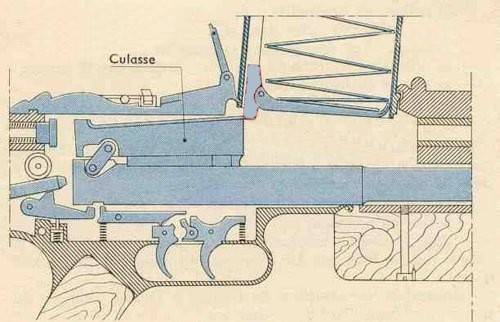
Scheme of the operation of the bolt frame and the bolt of the Chatellerault machine gun. Rice. armesfrancaises.free.fr
The barrel was screwed into the receiver like the Browning Automatic Rifle (BAR), so it could not be quickly and easily replaced in the field, unlike the Czech ZB vz. 26 and its British variant, the Bren machine gun. The operating instructions for the French army (July 1925) recommended not to allow more than 400 shots with continuous fire, since then it took ten to fifteen minutes for the machine gun to cool sufficiently. The optimal firing scheme from the FM 1924 was as follows: shooting four or five detachable magazines (from 100 to 125 rounds), then a short pause – and so on, to ensure stable operation of the machine gun.
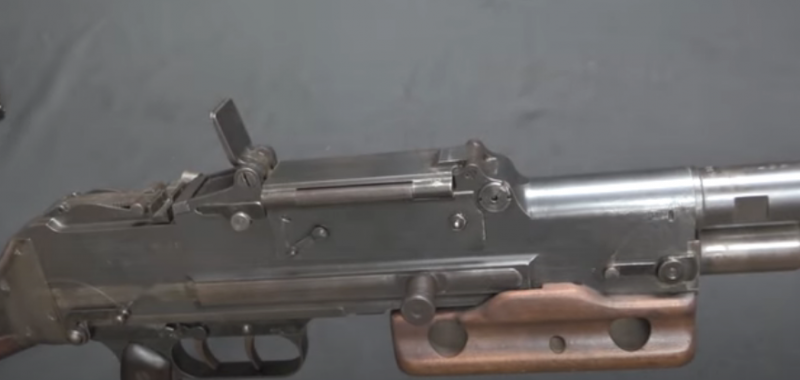
Receiver cover in the closed position. Photo forgottenweapons
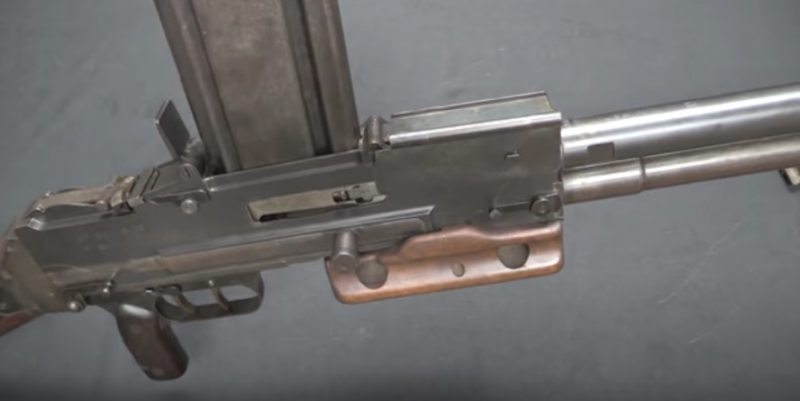
The lid is open, a magazine is inserted into the receiver. Photo forgottenweapons
The protection of all holes on the body of the machine gun from dirt and dust was thought out perfectly. For example, a single cover was provided on the machine gun for the magazine opening and the hole for extracting spent cartridges. The rate of fire was quite high – 450 rounds per minute, which made it possible to shoot for a long time without overheating the barrel. Since the machine gun was created on the basis of the prototype MAC 1923 of the Chatellerault weapons factory, for brevity they began to call it that.
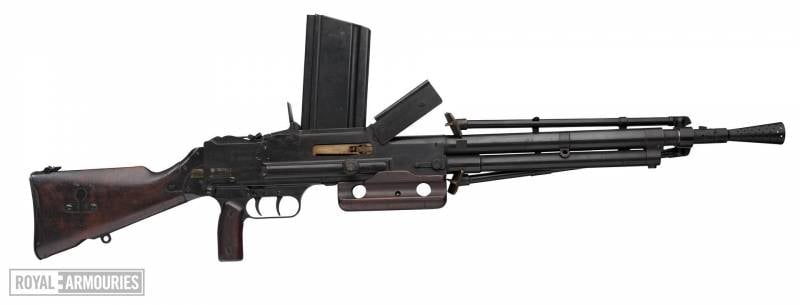
Machine gun with folded bipod. Royal Arsenal, Leeds
As already noted, the design of the machine gun was quite perfect, although not without flaws. So, due to the fact that the store was inserted from the top in the center, the sight had to be shifted to the left, which was inconvenient for left-handers. The side-folding front bipod was strong and light, but swung freely around the barrel rather than being fixed on it, which interfered with marksmanship. The holes on the wooden forearm made it possible to mount it on combat vehicles, which made it possible to use it as a light machine gun. It was also convenient for shooting from a position on the hip.
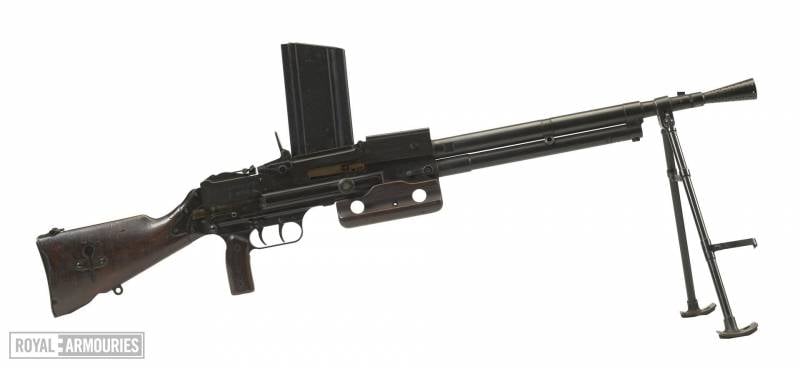
Machine gun with unfolded bipod. Royal Arsenal, Leeds
The soldiers of the French army really liked the new weapon, who first used it in battle on May 11, 1926 during the Rif War. As a result, the FM 24/29 became the standard automatic weapon of the French infantry and cavalry at the beginning of World War II. After the surrender of France in 1940, the Germans got a great many of these machine guns, as well as cartridges for them. So until the very end of the war, under the designations MG 115 (f) and MG 116 (f), they used them in their troops – in the Wehrmacht and the Volkssturm to defend the Atlantic Wall. MAC 24/29 was also used in limited numbers by the Finnish Defense Forces during the Winter War with the USSR, and then during the years of its participation in World War II. From 1943, when the French army was re-armed and reorganized in North Africa with Allied support, the FM 24/29 remained in service, as French troops considered it superior to the Browning automatic rifle.
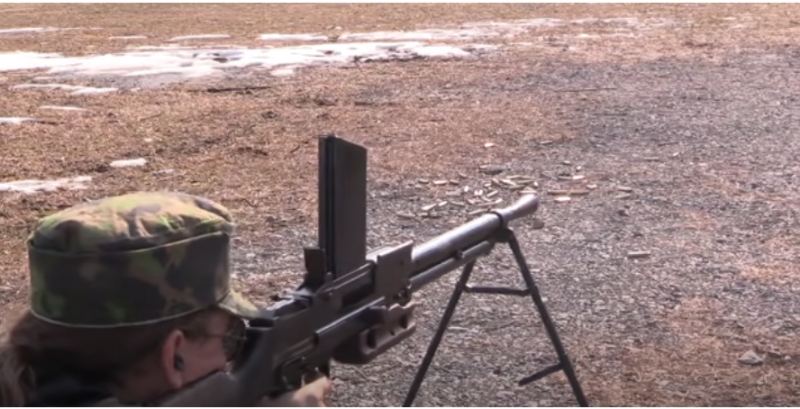
That’s how they shot him lying down. Photo forgottenweapons
There was a modification – “Machine gun arr. 1931″, originally intended for use on the fortifications of the Maginot Line, but later used for weapons tanks and other armored vehicles. This model had a peculiarly shaped stock and a side drum magazine for 150 rounds. The internal structure remained the same as on previous models, however, the barrel length was increased, due to which both the overall length of the machine gun and the muzzle velocity increased. Accordingly, the mass also increased, but since the French used these weapons in stationary positions or on the chassis of wheeled and tracked vehicles, this did not become a problem, and machine guns mod. 1931 in the pre-war period were produced in large quantities.
After the defeat of France in June 1940, the 1931 model of the year also began to be used by the Germans, most often as a tank – Kpfw MG 331 (f), and an anti-aircraft machine gun. The Germans, however, noted that all modifications of the Chatellerault machine gun had a number of shortcomings, primarily related to the cartridge used by the French: in their opinion, it was too low-power for them, so the firing range of them seemed small to them.
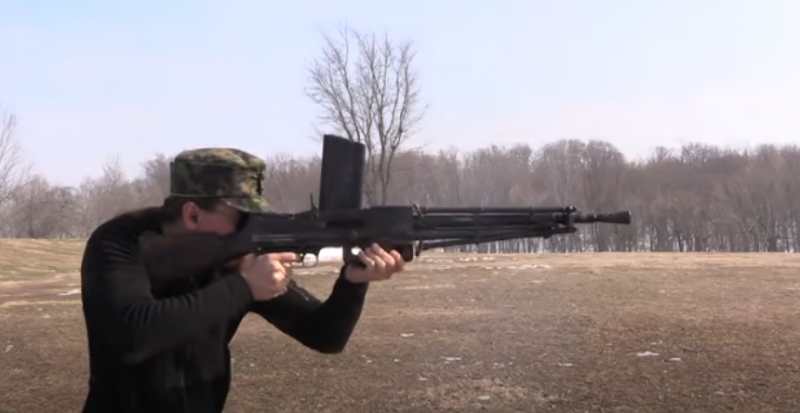
And so – standing! Photo forgottenweapons
As soon as World War II ended, the production of FM 24/29 machine guns was continued, so that during the First Indochina War it became the main workhorse of the French army and was used as an infantry squad weapon, and was put on jeeps modeled on the British SAS. The FM 24/29 was used by the French in Algeria, but it was replaced with the new AA-52 universal machine gun only in the 1960s. However, this did not mean that it was immediately handed over to warehouses.
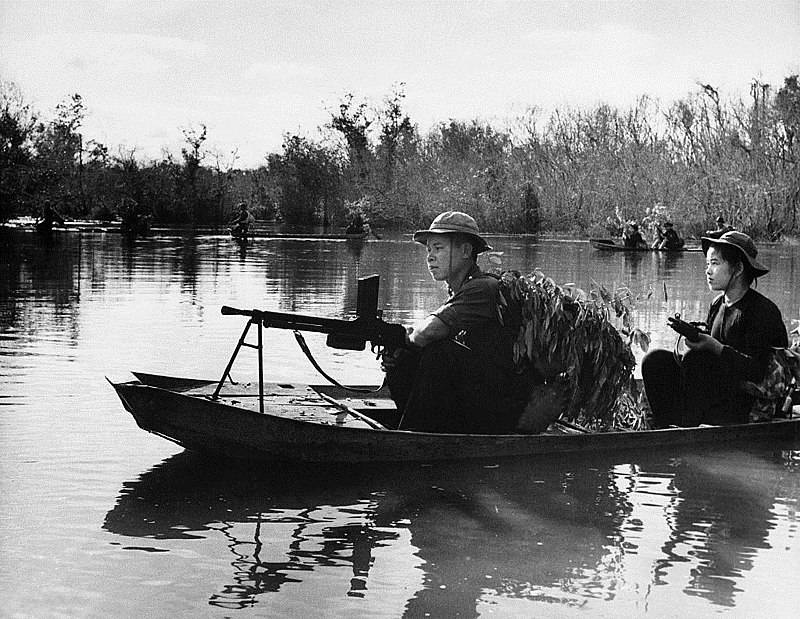
Viet Cong patrol, October 27, 1966
In Southeast Asia, he fought in the armed forces in Cambodia, Laos and Vietnam during the Indochina War. The fighters of the Viet Minh and Viet Cong, the People’s Army of Vietnam and the Army of the Republic of Vietnam were armed with this machine gun. In the Republic of Cambodia, it was used until 1989.
TTX FM 24/29
In service: 1925-1979 (French Army), 1956-2008 (national gendarmerie)
Manufacturer: Manufacture d’Armes de Châtellerault
Produced in 1925-1960s. 232 942 pcs.
Weight: 8,9 kg
Length: 1080 mm
Barrel length: 500 mm
Cartridge: 7,5 × 54 mm
Rate: 450 rounds per minute
Initial speed: 830 m / s
Effective range: 1250 m
Maximum firing range: 3950 m
Penetration: 70 cm of ground at 400 m (cartridge with an ordinary bullet)
Armor penetration: 3 mm steel at 400 m (cartridge with armor-piercing bullet)
Feeding System: 25-round detachable box magazine
- Author:
- Vyacheslav Shpakovsky